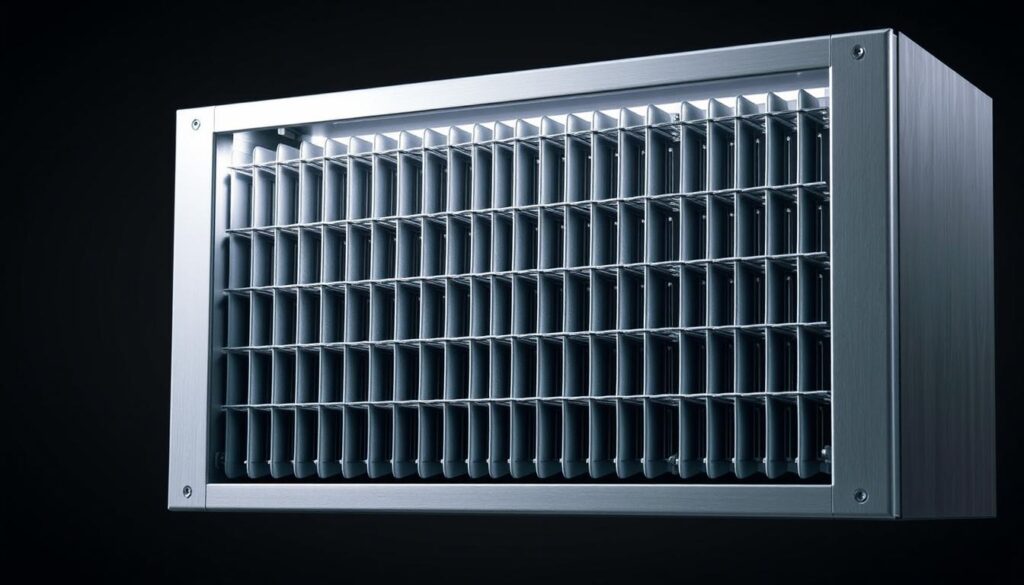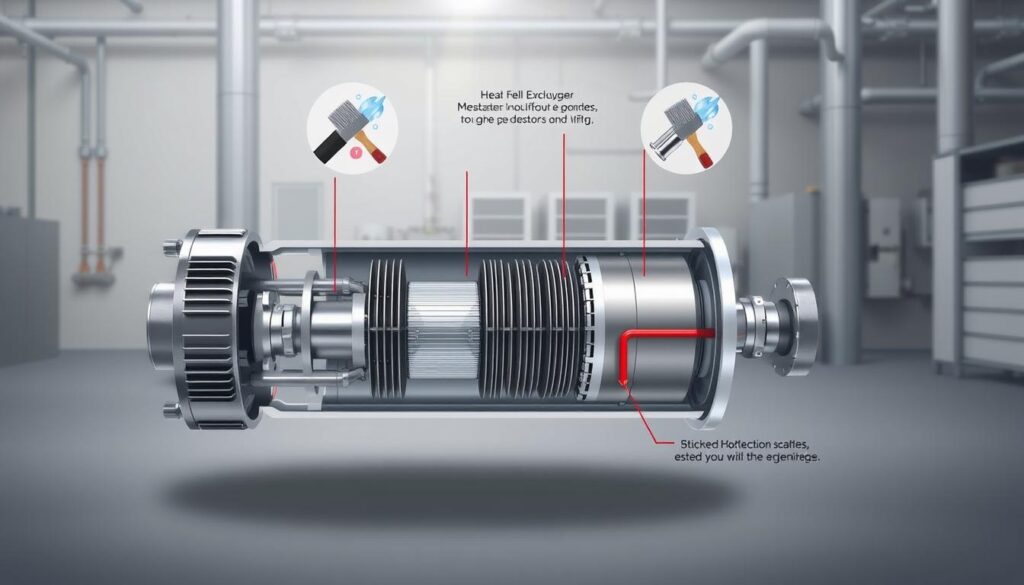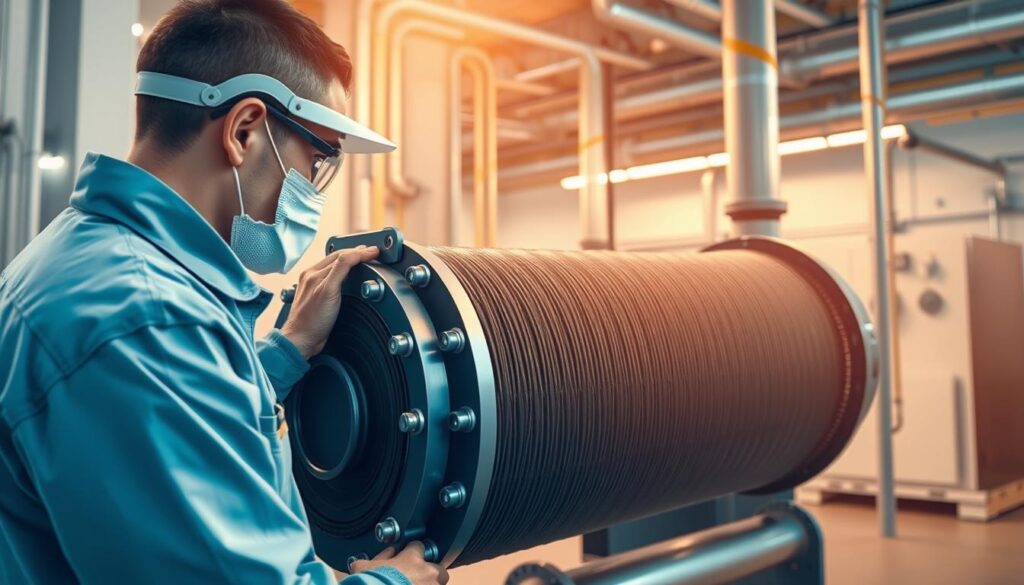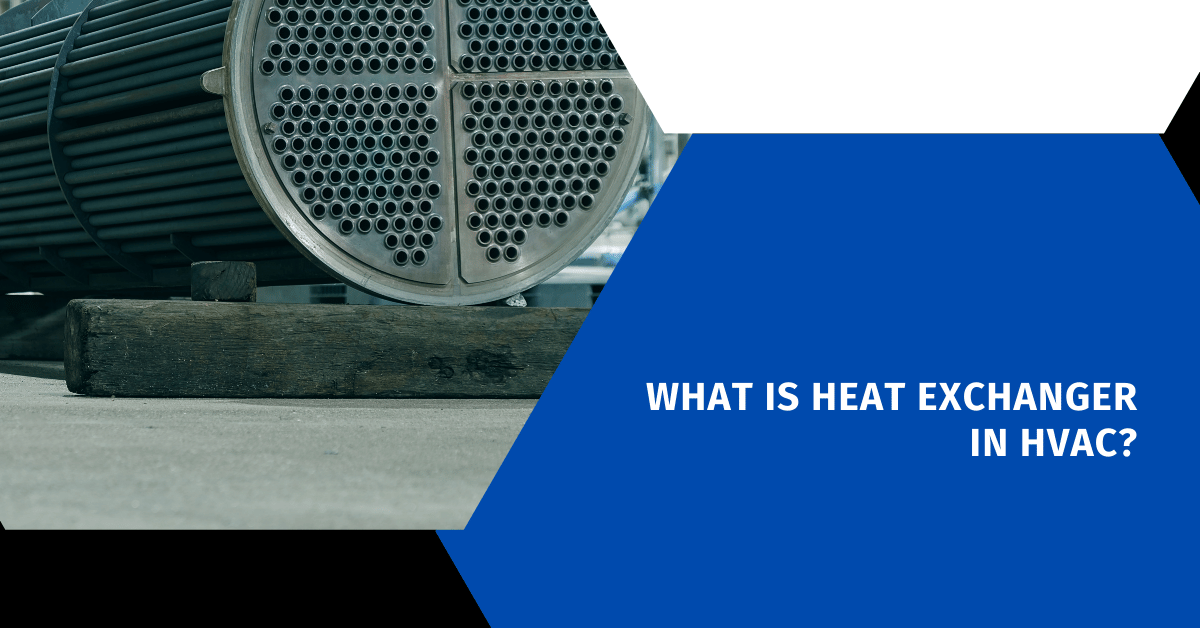Affiliate Disclosure
HVAC Guide Guys is a participant in the Amazon Services LLC Associates Program, an affiliate advertising program designed to provide a means for sites to earn advertising fees by advertising and linking to Amazon.
What is Heat Exchanger in HVAC? Ever wondered how your home stays comfy without magic? The answer is a cool device called a heat exchanger in HVAC systems. It’s like a secret dance of heat behind your walls.

A heat exchanger is key in heating, ventilation, and air conditioning systems. It moves heat from one fluid to another without touching. This helps keep your space at the right temperature.
In HVAC systems, heat exchangers are vital for a cozy indoor climate. They transfer heat between air, water, or refrigerant. This makes your home warm or cool while saving energy.
Key Takeaways
- Heat exchangers transfer thermal energy between different fluids
- Essential for efficient temperature control in buildings
- Enables heating and cooling without direct fluid mixing
- Supports energy-efficient HVAC performance
- Found in various applications from home systems to industrial processes
Table of Contents
Understanding Heat Exchangers in HVAC Systems
Heat exchangers are key parts of HVAC systems that help move thermal energy. They are vital for keeping indoor temperatures comfy and saving energy. Knowing about the different types of HVAC heat exchangers and how they work is important.
Basic Heat Transfer Methods
HVAC heat exchangers use three main ways to transfer heat:
- Conduction: Direct heat transfer through solid materials
- Convection: Heat transfer through fluid movement
- Radiation: Heat transfer through electromagnetic waves
Core Functions in HVAC Applications
Heat exchanger efficiency is key to their function. They are vital in many HVAC tasks, such as:
- Heating systems
- Cooling units
- Ventilation equipment
- Heat pump mechanisms
Energy Transfer Process
The energy transfer in heat exchangers involves three main flow setups. These setups affect how well heat exchangers work:
| Flow Type | Characteristics |
|---|---|
| Parallel-flow | Fluids move in same direction |
| Counter-flow | Fluids move in opposite directions |
| Cross-flow | Fluids move perpendicular to each other |
Understanding these basics helps us see how heat exchangers improve thermal management in HVAC systems. They ensure comfort and energy savings.
Explore Our HVAC Shop
Looking for top-rated HVAC tools, parts, and accessories? Visit our shop and find the perfect solution for your needs.
Visit the ShopWhat is Heat Exchanger in HVAC?
A heat exchanger in HVAC systems is key. It moves thermal energy between two mediums. It’s like the heart of your heating and cooling system, moving heat from one place to another.
It’s vital for managing indoor temperature and air quality.
Your HVAC system has two main types of heat exchangers:
- Evaporator Coil: Absorbs heat from indoor air during cooling
- Condenser Coil: Releases heat outside during the cooling process
The hvac cooling coil is very important. It removes heat and humidity from indoor air, making it comfortable. This happens when refrigerant goes through the coil, changing from liquid to gas and back.
“Heat exchangers are the unsung heroes of temperature control, silently working to keep your indoor environment comfortable.” – HVAC Engineering Experts
Different HVAC systems use different heat exchanger designs. But they all work on the same principle: to transfer thermal energy without mixing the mediums. They help keep your home cool in summer and warm in winter.
Knowing about heat exchangers in HVAC shows the complex engineering behind your comfort. These devices change how we experience indoor climate. They make modern living spaces more comfortable and energy-efficient.
Types of Heat Exchangers in HVAC Applications
Exploring HVAC heat exchangers reveals several key designs. Each plays a unique role in managing temperatures. They offer specific benefits for various heating and cooling tasks.
Knowing about different heat exchanger designs is key. It helps you pick the best one for your HVAC system needs. Let’s dive into the main types:
Shell and Tube Heat Exchangers
Shell and tube heat exchangers are staples in HVAC systems. They have multiple tubes inside a big shell. This setup allows for efficient heat exchange between fluids.
- Ideal for high-pressure applications
- Robust and durable construction
- Suitable for industrial and commercial HVAC systems
Plate Heat Exchangers for HVAC
Plate heat exchangers are a more compact, efficient choice. They use thin, wavy metal plates. This design boosts surface area and heat transfer.
- Extremely compact design
- High thermal efficiency
- Lower fluid volume requirements
Finned Tube Heat Exchangers
Finned tube heat exchangers shine in air-cooled setups. Their metal fins increase the surface area. This boosts heat transfer between air and fluids.
- Enhanced heat transfer performance
- Excellent for air conditioning systems
- Lightweight and versatile design
Choosing the right heat exchanger depends on your HVAC system’s needs. It also depends on pressure and thermal performance goals.
Explore Our HVAC Shop
Looking for top-rated HVAC tools, parts, and accessories? Visit our shop and find the perfect solution for your needs.
Visit the ShopHow Heat Exchangers Work in Furnaces
Knowing how hvac heat exchangers work in furnaces is key for efficient heating. A furnace heat exchanger is a vital part. It turns combustion energy into warm air for your home.
The heat exchanger acts as a smart barrier. It keeps combustion gases away from the air in your home. When your furnace lights up, the burners heat up the exchanger’s sealed area. This keeps harmful gases from mixing with the air you breathe.
- Combustion gases enter the heat exchanger through a bottom opening
- Heat is transferred to the metal walls of the exchanger
- Blower fans push air around the heated metal surfaces
- Warm air is distributed throughout your home
There are various furnace heat exchangers for different fuels like natural gas, oil, or electricity. Stainless steel and aluminized steel are often used. They are durable and good at transferring heat.
Keeping your heat exchanger in good shape is important. Regular checks can spot cracks or wear. This could harm its performance and safety. Experts suggest getting it checked every year to keep it working well.
Heat Exchanger Operation in Air Conditioning Systems
Air conditioning systems use complex heat transfer to keep your home cool. They change indoor temperatures through energy movement and refrigerant flow.
Your air conditioning system is like a smart heat pump. It moves heat from inside to outside. The hvac cooling coil is key in controlling temperatures.
Evaporator Coil Function
The evaporator coil is the main heat absorber in your system. It does several important things:
- Absorbs heat from indoor air
- Cools air through refrigerant expansion
- Reduces humidity
- Prepares air for circulation back inside
Condenser Heat Transfer Process
The condenser unit is outside and finishes the heat cycle by releasing heat. This stage is vital for:
- Compressing refrigerant to high temperatures
- Releasing heat outside
- Changing refrigerant back to liquid
| Component | Primary Function | Temperature Change |
|---|---|---|
| Evaporator Coil | Indoor Heat Absorption | Decreases Indoor Temperature |
| Condenser Unit | Heat Release | Increases External Temperature |
Knowing how these heat exchanges work shows the engineering in your cooling system. Keeping it well-maintained ensures it runs efficiently.
Explore Our HVAC Shop
Looking for top-rated HVAC tools, parts, and accessories? Visit our shop and find the perfect solution for your needs.
Visit the ShopCommon Heat Exchanger Problems and Maintenance

Your heat exchanger is a key part of your HVAC system. It needs regular care and maintenance. Knowing common problems can help avoid expensive fixes and make your furnace last longer.
Keeping your heat exchanger in good shape involves several important steps. Common issues that can affect your system’s performance include:
- Metal fatigue from constant temperature changes
- Corrosion and rust development
- Accumulation of debris and mineral deposits
- Structural cracks and stress points
The expansion and contraction of metal during heating and cooling can stress your heat exchanger. This stress can cause tiny cracks over time. These cracks can grow into big problems.
“Regular inspections are your best defense against unexpected heat exchanger failures,” says HVAC expert Mark Rodriguez.
Here are some important maintenance tips for your furnace heat exchanger:
- Schedule annual professional inspections
- Replace air filters every 3-6 months
- Keep air vents clean and unobstructed
- Monitor for unusual sounds or performance changes
Signs of heat exchanger trouble include strange smells, visible cracks, less heat, and odd noises. If you see any of these, call a professional HVAC tech right away. This can stop more damage.
Heat Exchanger Efficiency and Performance Factors
Knowing how heat exchanger efficiency works is key to better HVAC system performance. The success of HVAC heat exchangers depends on several important factors. These factors greatly affect energy transfer and how well the system works.
Several key performance factors are vital for heat exchanger efficiency. These elements greatly affect your system’s ability to move thermal energy well.
Temperature Differential Impact
The difference in temperature between fluid streams is key for heat transfer efficiency. A bigger temperature gap means faster and more efficient heat exchange. Your HVAC system’s performance depends on keeping the right temperature differences for best energy transfer.
- Wider temperature ranges increase heat transfer possibility
- Smaller temperature differences lower overall efficiency
- Accurate temperature control is vital for top performance
Flow Rate Considerations
Flow rates greatly affect heat exchanger efficiency. The speed and amount of fluid moving through the system impact heat transfer. Experts adjust flow rates to improve thermal exchange and cut down energy loss.
- Higher flow rates can boost heat transfer rates
- Too much flow might cause turbulence and lower efficiency
- Even flow rates ensure the best heat exchanger performance
Features like surface area optimization and special fin designs can also boost heat exchanger efficiency. These technical upgrades help your HVAC system transfer thermal energy better.
Explore Our HVAC Shop
Looking for top-rated HVAC tools, parts, and accessories? Visit our shop and find the perfect solution for your needs.
Visit the ShopSafety Considerations and Best Practices

Keeping your home and family safe starts with knowing about heat exchanger maintenance. Learning about furnace heat exchangers helps spot risks early. This way, you can take action to protect your loved ones.
Cracked heat exchangers are very dangerous. They can let toxic gases mix with the air you breathe. It’s important to get your heat exchanger checked by a pro to catch problems early.
- Recognize unusual furnace noises as possible warning signs
- Install carbon monoxide detectors near heating systems
- Make sure to have your heat exchanger checked every year
- Look out for visible cracks or rust
Keeping your heat exchanger in good shape involves some key steps. Experts say it’s best to have a thorough check-up. This includes:
| Inspection Area | Key Checks |
|---|---|
| Structural Integrity | Looking for cracks, rust, or damage |
| Combustion Performance | Checking the air-to-fuel mix |
| Seal Effectiveness | Checking if the combustion and air are fully separated |
If your furnace heat exchanger keeps giving you trouble, get it checked by a pro right away. Don’t try to fix it yourself. HVAC experts know how to safely find and fix problems with your heat exchanger.
Your family’s safety is in your hands with heat exchanger maintenance. Regular checks, quick fixes, and knowing the signs of trouble can keep your heating system safe and working well.
Conclusion
Learning about heat exchangers in HVAC shows how they are key to managing temperatures in buildings. These devices change how we control indoor temperatures, making spaces comfortable and energy-saving. Your HVAC system uses heat exchangers to move heat well across different areas and materials.
Heat exchangers are more than just parts. They are advanced engineering solutions for controlling temperatures in homes, offices, and factories. With designs like shell and tube and plate heat exchangers, they improve how we transfer heat. This makes our spaces more comfortable and eco-friendly.
As HVAC tech gets better, heat exchangers will get smarter and more efficient. New ideas aim to improve performance, cut energy use, and work better with digital systems. Knowing about these devices helps you make smart choices for your heating and cooling systems. This can save energy and lower costs.
Investing in good heat exchanger care, choice, and knowledge helps your HVAC system work best. Both pros and DIYers can learn a lot from these thermal transfer technologies. They work quietly to keep our indoor spaces just right.

